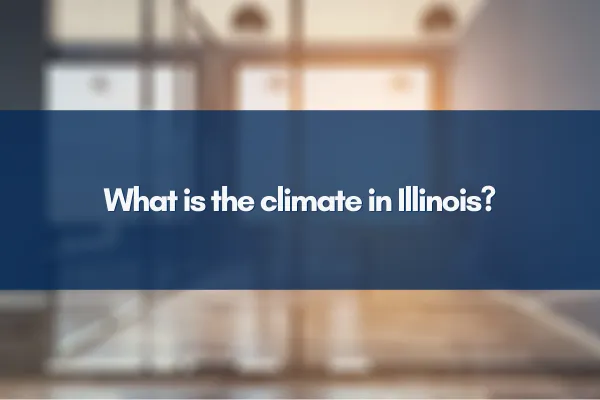How Much Is Your Home Worth?

What is the climate in Illinois?
What is the Climate in Illinois?
Imagine for a moment you’re stepping outside in Chicago, IL, wondering whether to grab your sunglasses or your snow boots. Illinois’ climate is a fascinating study in contrasts — a story of four distinct seasons that shape the life, culture, and even wardrobe of its residents. But what exactly defines Illinois’ climate, especially its seasonal moods?
Let’s dive deeper into the Illinois seasonal climate to understand why millions call this heartland state “home,” embracing hot summers, crisp autumns, snowy winters, and blooming springs. We’ll blend facts, data, and a little storytelling magic — Steve Jobs style — all sprinkled with SEO-friendly insights to boost your knowledge and maybe your Google ranking!
The Big Picture: Illinois' Climate is Continental, With a Twist
Illinois sits, broadly speaking, within what climate scientists call a continental climate zone. Here, you’ll experience big swings in temperature — which means Illinoisans really get to taste all four seasons.
Why "continental"? Because unlike coastal states buffered by oceans, Illinois’ weather is influenced largely by its position inland, far from the moderating effects of large water bodies. This results in:
Hot summers with temperatures often soaring well into the 80s and 90s °F.
Cold winters that can drop below freezing with significant snowfall.
Distinct seasonal changes making every quarter of the year feel unique.
Chicago, IL — The Urban Climate Signature
Now, Chicago adds its own twist to the Illinois climate story. Thanks to Lake Michigan, Chicago enjoys a lake-moderated climate on its eastern edge, which means slightly cooler summers and milder winters compared to much of the rest of Illinois.
Lake Effect: Winds picking up moisture from Lake Michigan can bring more snowfall in the winter – “lake-effect snow” is a well-known Chicago winter visitor.
Temperature Moderation: During summer, the lake acts as a natural air conditioner, cooling nearby neighborhoods by 5-10 degrees on some days.
However, this same cold lake can cause rapid temperature drops in spring and fall, leading to brief but dramatic weather changes.
Breaking Down the Illinois Seasonal Climate
Spring in Illinois: The Awakening
Springtime signals new beginnings. From March through May, Illinois transforms from a chilly, often gray landscape to one bursting with color and energy.
Average temps range from 40°F in March up to mid-60s in May.
Rainfall increases, helping crops and gardens bloom — though sometimes spring showers can surprise with heavy thunderstorms.
Tornado season starts heating up by late spring, a reminder of the Midwest’s stormy personality.
Fun fact: The famous “April showers bring May flowers” definitely holds here. But be ready for those quick spring storms that keep residents on their toes!
Summer Sizzle: Hot, Humid & Buzzing with Life
Summers are often considered the “most pleasant” by many Illinoisans, despite the heat.
July averages: High temps around 85-90°F, sometimes hitting that 100°F mark during heat waves.
Humidity can spike — it’s not uncommon to feel like you’re walking through a warm bath.
Thunderstorm season peaks, sometimes with dramatic lightning shows and even occasional severe weather.
Chicago’s lakeshore neighborhoods enjoy cooler temps from Lake Michigan breezes, but inland areas can really feel the heat.
Autumn: Nature’s Color Show & Comfort Zone
If fall is your jam, Illinois has you covered.
Temperatures gradually dip from the 70s in early fall to 40s and 50s by November.
That famous Illinois fall foliage lights up forests and parks in reds, oranges, and golds.
Dry, crisp air arrives making it the state’s unofficial “most pleasant” season.
People love autumn for comfortable outdoor activities – hiking, festivals, and weekend getaways feel ideal.
Winter: A Frozen Reality Check
Winter places Illinois in a “yes, we’re tough” mindset.
January averages: Highs near 30°F, lows often dipping below 15°F, sometimes into single digits.
Snowfall is common — Chicago averages about 36 inches annually, surrounding areas sometimes more.
Wind chills can cut through you (thank Lake Michigan again), making winter gear a necessity.
Snow doesn’t just inconvenience — it creates opportunities for winter sports and holiday festivities.
Frequently Asked Questions About Illinois Climate
Q1: What is the average annual temperature in Illinois?
Illinois averages about 52°F annually, but expect wide seasonal variation.
Q2: Does Chicago have more extreme weather than downstate Illinois?
Not necessarily more extreme, but Chicago’s proximity to Lake Michigan causes notable lake-effect weather like additional snow and temperature swings.
Q3: When is the best time to visit Illinois for pleasant weather?
Late spring (May) and early fall (September to October) are often cited as most pleasant for outdoor activities.
Why Understanding Illinois Climate Matters
Whether you’re planning a move, organizing outdoor events, or just curious, grasping Illinois’ diverse climate will help you prepare smarter. From picking the right wardrobe to knowing when to expect storms, the Illinois seasonal climate is more than numbers — it’s the rhythm of life here.
After all, nothing beats the thrill of those first blooms in spring or cozying up during a snowy Chicago winter night.
Ready to Explore Illinois Living?
If you’re thinking about making Illinois your home or just want expert advice about how climate factors into local real estate, reach out! I’m here to help you navigate everything with clarity and expertise.
📞 Contact: Sohail Salahuddin
📍 Title: Real Estate Broker
📲 Phone: 312-818-2978
📧 Email: [email protected]
🌐 Website: sohailrealestate.com
Did this deep dive into Illinois’ climate spark your curiosity? Share your experiences or questions in the comments below, and let’s chat about the seasons that define this incredible state!




